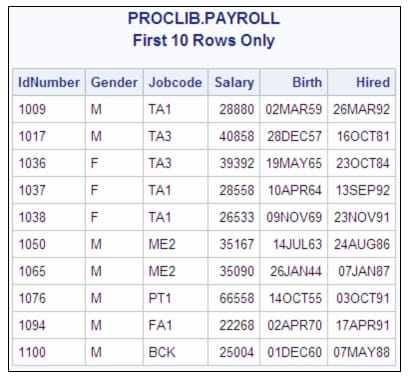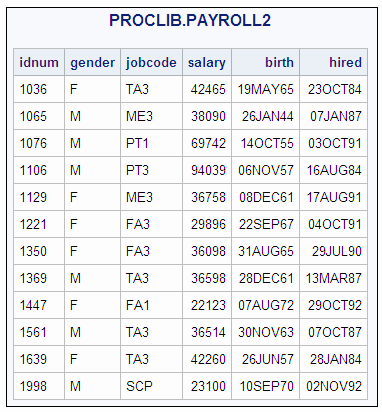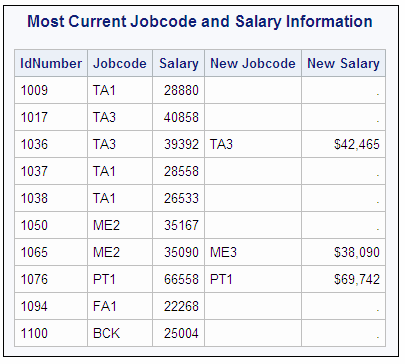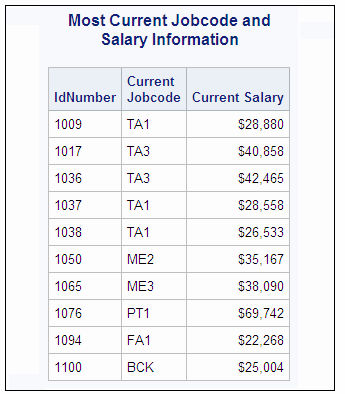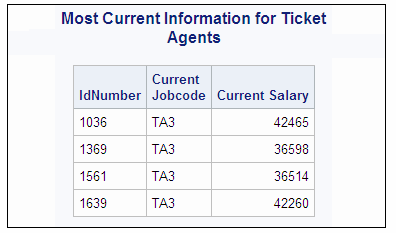SQL Procedure
- Syntax
 Procedure SyntaxPROC SQL StatementALTER TABLE StatementCONNECT StatementCREATE INDEX StatementCREATE TABLE StatementCREATE VIEW StatementDELETE StatementDESCRIBE StatementDISCONNECT StatementDROP StatementEXECUTE StatementINSERT StatementRESET StatementSELECT StatementUPDATE StatementVALIDATE Statement
Procedure SyntaxPROC SQL StatementALTER TABLE StatementCONNECT StatementCREATE INDEX StatementCREATE TABLE StatementCREATE VIEW StatementDELETE StatementDESCRIBE StatementDISCONNECT StatementDROP StatementEXECUTE StatementINSERT StatementRESET StatementSELECT StatementUPDATE StatementVALIDATE Statement - Overview
- Examples
 Creating a Table and Inserting Data into ItCreating a Table from a Query's ResultUpdating Data in a PROC SQL TableJoining Two TablesCombining Two TablesReporting from DICTIONARY TablesPerforming an Outer JoinCreating a View from a Query's Result Joining Three TablesQuerying an In-Line View Retrieving Values with the SOUNDS-LIKE Operator Joining Two Tables and Calculating a New ValueProducing All the Possible Combinations of the Values in a ColumnMatching Case Rows and Control RowsCounting Missing Values with a SAS Macro
Creating a Table and Inserting Data into ItCreating a Table from a Query's ResultUpdating Data in a PROC SQL TableJoining Two TablesCombining Two TablesReporting from DICTIONARY TablesPerforming an Outer JoinCreating a View from a Query's Result Joining Three TablesQuerying an In-Line View Retrieving Values with the SOUNDS-LIKE Operator Joining Two Tables and Calculating a New ValueProducing All the Possible Combinations of the Values in a ColumnMatching Case Rows and Control RowsCounting Missing Values with a SAS Macro
Example 7: Performing an Outer Join
| Features: |
joined-table component left outer join SELECT clause : COALESCE function WHERE clause : CONTAINS condition |
| Table names: | PROCLIB.PAYROLL |
Details
Program Using OUTER JOIN Based on ID Number
libname proclib 'SAS-library';
proc sql outobs=10;
title 'Most Current Jobcode and Salary Information';
select p.IdNumber, p.Jobcode, p.Salary,
p2.jobcode label='New Jobcode',
p2.salary label='New Salary' format=dollar8.
from proclib.payroll as p left join proclib.payroll2 as p2
on p.IdNumber=p2.idnum;
Program Description
Select the columns.The SELECT
clause lists the columns to select. Some column names are prefixed
with a table alias because they are in both tables. LABEL= and FORMAT=
are column modifiers.
select p.IdNumber, p.Jobcode, p.Salary,
p2.jobcode label='New Jobcode',
p2.salary label='New Salary' format=dollar8.Specify the type of join.The
FROM clause lists the tables to join and assigns table aliases. The
keywords LEFT JOIN specify the type of join. The order of the tables
in the FROM clause is important. PROCLIB.PAYROLL is listed first and
is considered the “left” table. PROCLIB.PAYROLL2 is
the “right” table.
Output for OUTER JOIN
Program Using COALESCE and LEFT JOIN
proc sql outobs=10;
title 'Most Current Jobcode and Salary Information';
select p.idnumber, coalesce(p2.jobcode,p.jobcode)
label='Current Jobcode',
coalesce(p2.salary,p.salary) label='Current Salary'
format=dollar8.
from proclib.payroll p left join proclib.payroll2 p2
on p.IdNumber=p2.idnum;Program Description
Select the columns and coalesce the Jobcode columns.The SELECT clause lists the columns to select. COALESCE
overlays the like-named columns. For each row, COALESCE returns the
first nonmissing value of either P2.JOBCODE or P.JOBCODE. Because
P2.JOBCODE is the first argument, if there is a nonmissing value for
P2.JOBCODE, COALESCE returns that value. Thus, the output contains
the most recent job code information for every employee. LABEL= assigns
a column label.
Coalesce the Salary columns.For
each row, COALESCE returns the first nonmissing value of either P2.SALARY
or P.SALARY. Because P2.SALARY is the first argument, if there is
a nonmissing value for P2.SALARY, then COALESCE returns that value.
Thus, the output contains the most recent salary information for every
employee.
Program to Subset the Query
proc sql;
title 'Most Current Information for Ticket Agents';
select p.IdNumber,
coalesce(p2.jobcode,p.jobcode) label='Current Jobcode',
coalesce(p2.salary,p.salary) label='Current Salary'
from proclib.payroll p left join proclib.payroll2 p2
on p.IdNumber=p2.idnum
where p2.jobcode contains 'TA';Program Description
Copyright © SAS Institute Inc. All rights reserved.
